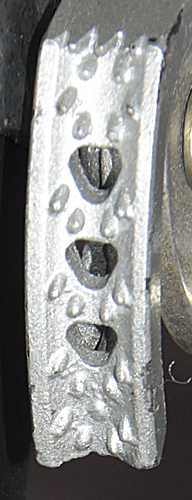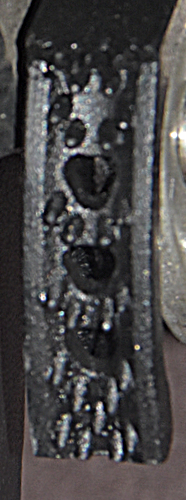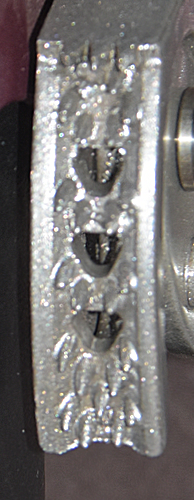Overview
[ Top
| Basic Version A
| Basic Version B
| Return to E.C. Ascenders
]
Multipurpose Ascender
(#1583)
Technical Details
I acquired my Krok Multipurpose Ascender from Gear4Rocks in 2012.
The Krok Multipurpose Ascender is 102 mm. tall, 76 mm. wide, 30 mm. thick, and weighs 142 g.
 The ascender shell
is subtriangular shape bent from 3.5 mm.
aluminum sheet. The rope channel is formed by bending the left
side of the ascender into a U. The rope channel is 16 mm. wide. The main sling attachment point is a 14.8 mm.
hole located below the cam near the rope channel. A second attachment
point consists of an 18.3 by 15.4 mm. inverted pear-shaped hole through the rope
channel U, just above the cam. The right end of the shell is
bent on an inclined axis to form another U. A hole drilled through
both sides of the U accepts a semi-tubular rivet. The cam and cam spring
are mounted on this rivet. The head of the rivet sits into a stamped
depression on the back of the cam, while the roll is exposed on
the open side. The pivot is centered 48 mm. from the inside
of the rope groove. A pattern of reinforcing ribs stiffens the rear of the shell.
The ascender shell
is subtriangular shape bent from 3.5 mm.
aluminum sheet. The rope channel is formed by bending the left
side of the ascender into a U. The rope channel is 16 mm. wide. The main sling attachment point is a 14.8 mm.
hole located below the cam near the rope channel. A second attachment
point consists of an 18.3 by 15.4 mm. inverted pear-shaped hole through the rope
channel U, just above the cam. The right end of the shell is
bent on an inclined axis to form another U. A hole drilled through
both sides of the U accepts a semi-tubular rivet. The cam and cam spring
are mounted on this rivet. The head of the rivet sits into a stamped
depression on the back of the cam, while the roll is exposed on
the open side. The pivot is centered 48 mm. from the inside
of the rope groove. A pattern of reinforcing ribs stiffens the rear of the shell.
The cam is a plated skeletonized steel casting. The cam radius,
measured from the pivot, increases from 37 to 58 mm. over an angle of 41°, giving a 32° cam angle.
The tooth pattern is (3.2)(2.2.H)^3(2.2.3.2). A spring-loaded manual safety
bar pivots on an axle riveted to the cam. The normal action of
the spring holds the safety against the cam. When the cam is opened,
the shell interferes with the safety bar, thus preventing opening
the cam. If the safety bar is moved away from the cam (opposing
the spring), it will clear the shell and the cam will open. At
full open the safety can be released and the spring will hold
the safety against the back of the shell. This provides a means
of locking the cam open. Two pins on the safety assist in operating
the safety mechanism.
There are no identifying markings on this ascender.
The cam safety is both awkward an unique. Opening the ascender
one-handed is rather difficult. When the cam hold-open is active,
releasing the cam is easy; a light tap will cause the spring to pull the cam closed.
The workmanship and finish on the Krok are adequate but inferior to many Western ascenders. Gear4Rocks advertises their equipment as "functional, serviceable, affordable & safe, not pretty or trendy." The ascender design has been tested by "STANDART," the Ukrainian National Scientific-Certification Center in Kiev, the capital of Ukraine. Testing procedures are based on CE and UIAA standards.
[ Top
| Multipurpose
| Basic Version B
| Return to E.C. Ascenders
]
Basic, Version A
(Бейсик)
(3602_0451.37)
(#2992)
Technical Details
I acquired my Krok Basic, Version A from Krok in 2021.
Version A is 102 mm. tall, 75 mm. wide, 30 mm. thick, and weighs 148 g.
 The ascender shell
is subtriangular shape bent from 3.5 mm.
aluminum sheet. The rope channel is formed by bending the left
side of the ascender into a U. The rope channel is 16 mm. wide. The main sling attachment point is a 14.7 mm.
hole located below the cam near the rope channel. A second attachment
point consists of an 18.4 by 13.9 mm. inverted pear-shaped hole through the rope
channel U, just above the cam. The right end of the shell is
bent on an inclined axis to form another U. A hole drilled through
both sides of the U accepts a semi-tubular rivet. The cam and cam spring
are mounted on this rivet. The head of the rivet sits into a stamped
depression on the back of the cam, while the roll is exposed on
the open side. The pivot is centered 50 mm. from the inside
of the rope groove. A pattern of reinforcing ribs stiffens the rear of the shell.
The ascender shell
is subtriangular shape bent from 3.5 mm.
aluminum sheet. The rope channel is formed by bending the left
side of the ascender into a U. The rope channel is 16 mm. wide. The main sling attachment point is a 14.7 mm.
hole located below the cam near the rope channel. A second attachment
point consists of an 18.4 by 13.9 mm. inverted pear-shaped hole through the rope
channel U, just above the cam. The right end of the shell is
bent on an inclined axis to form another U. A hole drilled through
both sides of the U accepts a semi-tubular rivet. The cam and cam spring
are mounted on this rivet. The head of the rivet sits into a stamped
depression on the back of the cam, while the roll is exposed on
the open side. The pivot is centered 50 mm. from the inside
of the rope groove. A pattern of reinforcing ribs stiffens the rear of the shell.
The cam is a painted skeletonized steel casting. The cam radius increases from 37 to 58 mm. over an angle of 42°, giving a 31° cam angle. The tooth pattern is (3.2.2)(1H1.2)^3(2.3.2). A spring-loaded manual safety
bar pivots on an axle riveted to the cam. The normal action of
the spring holds the safety against the cam. When the cam is opened,
the shell interferes with the safety bar, thus preventing opening
the cam. If the safety bar is moved away from the cam (opposing
the spring), it will clear the shell and the cam will open. At
full open the safety can be released and the spring will hold
the safety against the back of the shell. This provides a means
of locking the cam open. Two pins on the safety assist in operating
the safety mechanism.
The front of the rope channel on each ascender is printed with a hollow up-pointing arrow with "WLL 4kN" inside, the Krok logo, "1803.1301," and a book-with-an-"i" icon.
The Krok Basic, Version A, model krk 3602_0451.37 (Бейсик) that I acquired in 2021 is identical to the Krok Multipurpose Ascender that I acquired in 2012, except that the cam is painted black and there are markings on the shell. Krok’s workmanship has improved noticeably in the intervening nine years.
[ Top
| Multipurpose
| Basic Version A
| Return to E.C. Ascenders
]
Basic, Version B
(Бейсик)
(3602_1445.34 LH, 3602_1445.36 RH)
(#2993/2994)
Technical Details
I acquired my Krok Basics, Version B from Krok in 2021.
Version B is available in left- and right-handed variations. Each is 104 mm. tall, 73 mm. wide, 28 mm. thick, and weighs 189 g.
I'll describe the right-handed ascender; you can mentally reverse left ↔ right for the left-handed one.
The rope channel is 16 mm. wide. The pivot is centered 49 mm. from the inside of the rope channel. The cam radius increases from 37 to 58 mm. over an angle of 42°, giving a 31° cam angle. The tooth pattern is (3.2.2)(1H1.2)^3(2.3.2).
 The ascender shell
is subtriangular shape bent from 1.9 mm.
steel sheet. The rope channel is formed by bending the left
side of the ascender into a U. The rope channel is 16 mm. wide. The main sling attachment point is a 14.8 mm.
hole located below the cam near the rope channel. A second attachment
point consists of an 18.3 by 15.0 mm. inverted pear-shaped hole through the rope
channel U, just above the cam. The right end of the shell is
bent on an inclined axis to form another U. A hole drilled through
both sides of the U accepts a semi-tubular rivet. The cam and cam spring
are mounted on this rivet. The head of the rivet sits into a stamped
depression on the back of the cam, while the roll is exposed on
the open side. The pivot is centered 49 mm. from the inside
of the rope groove. A pattern of reinforcing ribs stiffens the rear of the shell.
The ascender shell
is subtriangular shape bent from 1.9 mm.
steel sheet. The rope channel is formed by bending the left
side of the ascender into a U. The rope channel is 16 mm. wide. The main sling attachment point is a 14.8 mm.
hole located below the cam near the rope channel. A second attachment
point consists of an 18.3 by 15.0 mm. inverted pear-shaped hole through the rope
channel U, just above the cam. The right end of the shell is
bent on an inclined axis to form another U. A hole drilled through
both sides of the U accepts a semi-tubular rivet. The cam and cam spring
are mounted on this rivet. The head of the rivet sits into a stamped
depression on the back of the cam, while the roll is exposed on
the open side. The pivot is centered 49 mm. from the inside
of the rope groove. A pattern of reinforcing ribs stiffens the rear of the shell.
The cam is a painted skeletonized casting. The cam radius increases from 37 to 58 mm. over an angle of 42°, giving a 31° cam angle. The tooth pattern is (3.2.2)(1H1.2)^3(2.3.2). A spring-loaded manual safety
bar pivots on an axle riveted to the cam. The normal action of
the spring holds the safety against the cam. When the cam is opened,
the shell interferes with the safety bar, thus preventing opening
the cam. If the safety bar is moved away from the cam (opposing
the spring), it will clear the shell and the cam will open. At
full open the safety can be released and the spring will hold
the safety against the back of the shell. This provides a means
of locking the cam open. Two pins on the safety assist in operating
the safety mechanism.
The front of the rope channel is printed with "Max 300 кг," a hollow up-pointing arrow,"MBS 15kN," the Krok logo, "20.01.06.04" on the left- and "20.01.06.03" on the right-handed ascender, and a book-with-an-"i" icon.
The cam metal has changed. I could not find out what it was from Krok’s web site (they describe it as high-carbon hardened steel, but this describes the older cam). It may be stainless steel since it is nonmagnetic and seems to be too hard to be aluminum.
The three teeth in the top row of the cam are longer than the others, giving a more aggressive bite on the rope.
The steel shells are stronger than the aluminum ones used in other versions, but they are also heavier, adding about 100 g. to the weight of each ascender. My preference is for aluminum, which has adequate strength, is lighter, and will not rust.
[ Top
| Multipurpose
| Basic Version A
| Basic Version B
]


